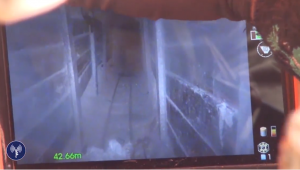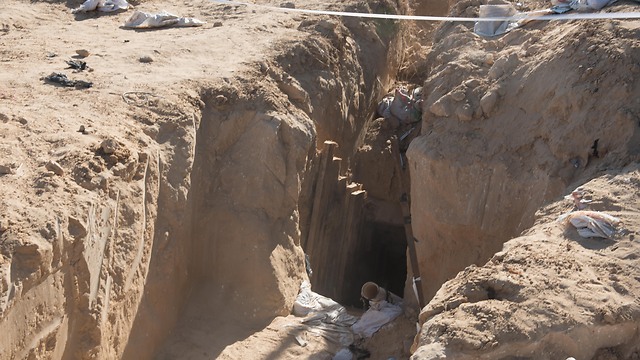
The newer tunnels built after Operation Protective Edge benefit from sturdier construction methods, improving structural integrity, which make them less likely to collapse due to rainfall.
By Ynet reporters

New-style Hamas tunnel, right, old-style Hamas tunnel, left – Photo: IDF spokesperson
In this type of construction, the wide vertical slabs are the weak point, and that is why Hamas is now building its tunnels using long, narrow concrete slabs laid horizontally, one on top of the other, within a metal frame.
This structure is much stronger and more durable. I can withstand not only the pressure from the soil overhead, but also explosions and fighting inside the tunnel. It also allows for safer working conditions on rainy days when water seeps into the work area.
The recently discovered tunnel was dug at a depth of 20 to 30 meters. Too much rainfall could cause the soil above a tunnel built using the pre-Protective Edge method to collapse, as seen several times in recent months. The new structure makes it far less likely that the tunnel would collapse.
Meir Rofe, the technical director of Shaffir Engineering, explained just how much progress the tunnel diggers have shown since Operation Protective Edge. “You can’t see clearly if the new segments are wood, iron, or concrete. But in the old method, they didn’t connect the concrete slabs together, only placed them close together. Perhaps that’s also the reason they experienced collapses, and why they decided to build it lengthwise and (make) the tunnel sturdier.”
Rofe explained that now, “The columns that are holding the segments can withstand great pressure, but it’s impossible to know how stable they are inside a tunnel, and how long they’ll be able to handle all of that weight. You can tell that the Palestinians are using tracks to move materials. Their logistical work has improved. They usually dig by hand, since it’s Kurkar (sandstone), not solid rock.”

The new tunnel discovered two weeks ago – Photo: IDF Spokesman’s Unit
“As primitive as the means are, they do the job for them, but these are not tunnels you’d want to pass through, they’re problematic and unstable and may collapse,” he added.
Recent months have seen a significant increase in the number of collapses of tunnels dug by Hamas’s military wing, the Izz ad-Din al-Qassam Brigades, in the Gaza Strip. At least nine tunnels collapsed so far, costing at least 15 people their lives – which raised awareness of the topic in the Palestinian media as well.

The new tunnel discovered two weeks ago – Photo: IDF Spokesman’s Unit
The Hamas regime in Gaza attempted to cover up the matter at first, but news of the collapses leaked onto social media. Hamas leaders quickly realized they couldn’t stop the flow of this information, especially with casualties involved. It is not out of the question, however, that the terrorist organization has been able to hide the fact that other tunnels have also collapsed.
Ron Ben-Yishai, Elior Levy and Noam (Dabul) Dvir contributed to this report.
View original Ynet publication at:
http://www.ynetnews.com/articles/0,7340,L-4793193,00.html







 Israeli New Shekel Exchange Rate
Israeli New Shekel Exchange Rate